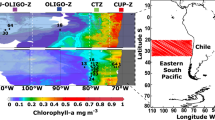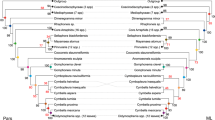Abstract
Bipolarity, the presence of a species in the high latitudes separated by a gap in distribution across the tropics, is a well-known pattern of global species distribution. But the question of whether bipolar species have evolved independently at the poles since the establishment of the cold-water provinces 16–8 million years ago, or if genes have been transferred across the tropics since that time, has not been addressed. Here we examine genetic variation in the small subunit ribosomal RNA gene of three bipolar planktonic foraminiferal morphospecies. We identify at least one identical genotype in all three morphospecies in both the Arctic and Antarctic subpolar provinces, indicating that trans-tropical gene flow must have occurred. Our genetic analysis also reveals that foraminiferal morphospecies can consist of a complex of genetic types. Such occurrences of genetically distinct populations within one morphospecies may affect the use of planktonic foraminifers as a palaeoceanographic proxy for climate change and necessitate a reassessment of the species concept for the group.
This is a preview of subscription content, access via your institution
Access options
Subscribe to this journal
Receive 51 print issues and online access
$199.00 per year
only $3.90 per issue
Buy this article
- Purchase on Springer Link
- Instant access to full article PDF
Prices may be subject to local taxes which are calculated during checkout



Similar content being viewed by others
References
Crame,J. A. Bipolar molluscs and their evolutionary implications. J. Biogeogr. 20, 145–161 ( 1993).
Lindberg,D. R. Marine biotic interchange between the northern and southern hemispheres. Paleobiology 17, 308–324 (1991).
Darwin,C. The Origin of Species by Means of Natural Selection, or the Preservation of Favoured Races in the Struggle for Life (John Murray, London, 1859).
Hooker,J. D. The Botany. The Antarctic Voyage of H. M. Discovery Ships Erebus and Terror, in the Years 1839-1843 (Reeve Brothers, London, 1847 ).
Ross,J. C. A Voyage of Discovery and Research in the Southern and Antarctic Regions, during the Years 1839-43 (John Murray, London, 1847 ).
Darling,K. F., Wade,C. M. Kroon,D. & Leigh Brown,A. J. Planktic foraminiferal molecular evolution and their polyphyletic origins from benthic taxa. Mar. Micropaleontol. 30, 251– 266 (1997).
de Vargas,C., Zaninetti,L., Hilbrecht,H. & Pawlowski,J. Phylogeny and rates of molecular evolution of planktonic foraminifera: SSU rDNA sequences compared to the fossil record. J. Mol. Evol. 45, 285–294 (1997).
Bé,A. W. H. in Oceanic Micropaleontology (ed. Ramsey, A. T. S.) 1– 100 (Academic, London, 1977).
Darling,K. F., Wade,C. M., Kroon,D., Leigh Brown,A. J. & Bijma, J. The diversity and distribution of modern planktic foraminiferal small subunit ribosomal RNA genotypes and their potential as tracers of present and past ocean circulations. Paleoceanography 14, 3–12 (1999).
Huber,B. T., Bijma,J. & Darling,K. F. Cryptic speciation in the living planktonic foraminifer Globigerinella siphonifera (d’Orbigny). Paleobiology 23, 33–62 ( 1997).
de Vargas,C., Norris,R., Zaninetti,L., Gibb,S. W. & Pawlowski, J. Molecular evidence of cryptic speciation in planktonic foraminifers and their relation to oceanic provinces. Proc. Natl Acad. Sci. USA 96, 2864–2868 (1999).
Knowlton,N. Sibling species in the sea. Annu. Rev. Ecol. Systematics 24, 189–216 (1993).
Kennett,J. P. & Srinivasan,M. S. Neogene Planktonic Foraminifera, a Phylogenetic Atlas (Hutchinson and Ross, Stroudsburg, Pennsylvania, 1983).
Spezzaferri,S. Planktonic foraminiferal biostratigraphy of the Oligocene and lower Miocene in the oceanic record. An overview. Palaeontogr. Italica 81, 1–187 (1994).
Hilbrecht,H. Morphologic gradation and ecology in Neogloboquadrina pachyderma and N. dutertrei (planktic foraminifera) from core top sediments. Mar. Micropaleontol. 31, 31–43 (1997).
Brummer,G. A. & Kroon,D. in Planktonic Foraminifers as Tracers of Ocean-climate History (eds Brummer, G. A. & Kroon, D.) 293–298 (Free University, Amsterdam, 1988).
Pawlowski,J. et al. Extreme differences in rates of molecular evolution of foraminifera revealed by comparison of ribosomal DNA sequences and the fossil record. Mol. Biol. Evol. 14, 498–505 (1997).
de Vargas,C. & Pawlowski,J. Molecular versus taxonomic rates of evolution in planktonic foraminifera. Mol. Phyl. Evol. 9, 463–469 (1998).
Kennett,J. P., Keller,G. & Srinivasan, M. S. Miocene planktonic foraminiferal biogeography and paleoceanographic development of the Indo-Pacific region. Geol. Soc. Am. 163, 197–236 ( 1985).
McIntyre,A., Ruddiman,W. F., Karlin,K. & Mix,A. C. Surface water response of the equatorial Atlantic Ocean to orbital forcing. Paleoceanography 4, 19– 55 (1989).
Guilderson,T. P., Fairbanks,R. G. & Rubenstone, J. L. Tropical temperature variations since 20,000 years ago: modulating interhemispheric climate change. Science 263, 663–665 (1994).
Stute,M. et al. Cooling of tropical Brazil (5°C) during the last glacial maximum. Science 269, 379– 383 (1995).
Schrag,D. P., Hampt,G. & Murray,D. Pore fluid constraints on the temperature and oxygen isotopic composition of the glacial ocean. Science 272, 1930– 1932 (1996).
Wolff,T., Mulitza,S., Arz,H., Pätzold,F. & Wefer, G. Oxygen isotopes versus CLIMAP (18ka) temperatures: a comparison from the tropical Atlantic. Geology 26, 675–678 (1998).
CLIMAP Project Members. Seasonal reconstructions of the Earth's surface at the last glacial maximum. Geol. Soc. Am. Map Chart Ser. MC-36, 1– 18 (1981).
Mix,A. C. & Morey,A. E. in The South Atlantic: Present and Past Circulation (eds Wefer, G., Berger, W. H., Siedler, G. & Webb, D. J.) 503–525 (Springer, Berlin, 1996).
Zhao,M., Beveridge,N. A. S., Shackleton, N. J., Sarnthein,M. & Eglinton,G. Molecular stratigraphy of cores off northwest Africa: Sea surface temperature history over the last 80 ka. Paleoceanography 10, 661– 675 (1995).
Palumbi,S. R. Genetic divergence, reproductive isolation, and marine speciation. Annu. Rev. Ecol. Systematics 25, 547– 572 (1994).
Coyne,J. A. & Orr,H. A. The evolutionary genetics of speciation. Phil. Trans. R. Soc. Lond. B 353, 287– 305 (1998).
Bijma,J., Erez,J. & Hemleben,C. Lunar and semi-lunar reproductive cycles in some spinose planktonic foraminifers. J. Foram. Res. 20, 117–127 (1990).
Metz,E. C. & Palumbi,S. R. Positive selection and sequence rearrangements generate extensive polymorphism in the gamete recognition protein bindin. Mol. Biol. Evol. 13, 397– 406 (1996).
Biermann,C. H. The molecular evolution of sperm bindin in six species of sea urchins (Echinoida: Strongylocentrotidae). Mol. Biol. Evol. 15, 1761–1771 (1998).
Dieckmann,U. & Doebeli,M. On the origin of species by sympatric speciation. Nature 400, 354– 357 (1999).
Tregenza,T. & Butlin,R. K. Speciation without isolation. Nature 400, 311–312 ( 1999).
Darling,K. F., Kroon,D., Wade,C. M. & Leigh Brown,A. J. Molecular evolution of planktic foraminifera. J. Foram. Res. 26, 324–330 (1996).
Smith,S. W., Overbeek,R., Woese,C. R., Gilbert,W. & Gillevet, P. M. The genetic data environment, an expandable GUI for multiple sequence analysis. Comput. Appl. Biosci. 10 , 671–675 (1994).
Saitou,N. & Nei,M. The neighbor-joining method: A new method for reconstructing phylogenetic trees. Mol. Biol. Evol. 4, 406–425 (1987).
Swofford,D. L. PAUP*. Phylogenetic Analysis using Parsimony (*and Other Methods) V. 4 (Sinauer Associates, Sunderland, Massachusetts, 1998).
Felsenstein,J. Confidence limits on phylogenies: an approach using the bootstrap. Evolution 39, 783–791 ( 1985).
Tappan,H. & Loeblich,A. R. Foraminiferal evolution, diversification and extinction. J. Paleontol. 62, 695– 714 (1988).
Acknowledgements
Acknowledgements We thank C. Pudsey and T. Paramour for their assistance during the 1997 Antarctic cruise on RRS James Clark Ross (British Antarctic Survey), and S. Troelstra and colleagues for their support during the 1997 Denmark Strait expedition on RV Professor Logachev (Netherlands Foundation for Scientific Research and the Geological Survey of Denmark and Greenland). We also thank A. Davison, S. Goodacre, J. Brookfield, P. Sharp and B. Clarke for discussions and comments on the manuscript. This work was supported by the Leverhulme Trust, the Carnegie Trust for the Universities of Scotland and the NERC.
Author information
Authors and Affiliations
Corresponding author
Rights and permissions
About this article
Cite this article
Darling, K., Wade, C., Stewart, I. et al. Molecular evidence for genetic mixing of Arctic and Antarctic subpolar populations of planktonic foraminifers. Nature 405, 43–47 (2000). https://doi.org/10.1038/35011002
Received:
Accepted:
Issue Date:
DOI: https://doi.org/10.1038/35011002
This article is cited by
-
Annual phytoplankton dynamics in coastal waters from Fildes Bay, Western Antarctic Peninsula
Scientific Reports (2021)
-
Decadal variability in twentieth-century ocean acidification in the California Current Ecosystem
Nature Geoscience (2020)
-
Planktonic foraminifera genomic variations reflect paleoceanographic changes in the Arctic: evidence from sedimentary ancient DNA
Scientific Reports (2020)
-
Modern planktonic foraminifera from the eastern Indian Ocean
Acta Oceanologica Sinica (2018)
-
Metadata-mining of 18S rDNA sequences reveals that “everything is not everywhere” for glomeromycotan fungi
Annals of Microbiology (2016)
Comments
By submitting a comment you agree to abide by our Terms and Community Guidelines. If you find something abusive or that does not comply with our terms or guidelines please flag it as inappropriate.



